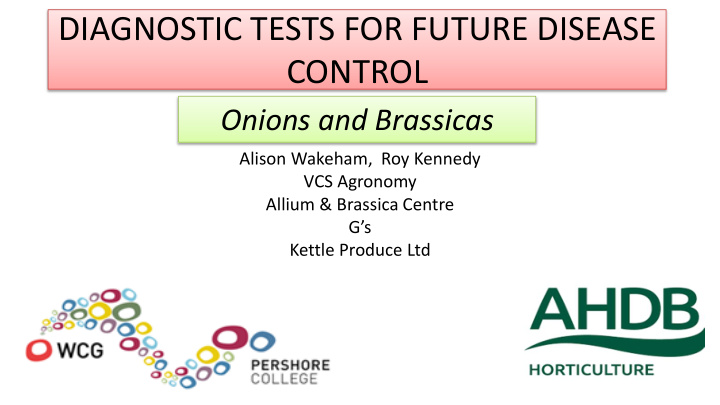



DIAGNOSTIC TESTS FOR FUTURE DISEASE CONTROL Onions and Brassicas Alison Wakeham, Roy Kennedy VCS Agronomy Allium & Brassica Centre G’s Kettle Produce Ltd
Onion downy mildew prediction • Review progress • Do we need a system? • Current work • Future development
Review PERSHORE: Onion DM (15 Jun 2015) 6 • Forecasting models Sporulation 4 2 • Spore detection 0 10/05 17/05 24/05 31/05 07/06 14/06 1 • Trials Infection 0.5 1000000 0 spores spores 0 10/05 17/05 24/05 31/05 07/06 14/06 1 Latent Period 0.5 Moderate to High Low disease risk High risk of disease 0 10/05 17/05 24/05 31/05 07/06 14/06 Date (Day/Month)
Integrated use with MILIONCAST to forecast risk in commercial salad and onion crops (AHDB study) Site 2. Bulb Onions (Red Tide) drilled 20/03/2014 Results • seven day spray interval • forecast (AHDB study) • No control measures The total number of bulb onion plants exhibiting applied downy mildew symptoms across the two middle rows of each 10m treatment block
Need for forecasting • Ok at present? – spray 7-10 days x 8 • Logistics – large area, spray days/timing • Protection rather than cure • Environmental benefit • Approval changes: – Revocation of actives – Reduced applications – New actives • Overall fewer applications – Targeting with DSS
2017 development work FV456 – ‘Delivery of a Diagnostic test scheme for Brassicas and Onions’ • 2 year project • Pershore College and Mologic • Grower participation
Stoneleigh site: Trap located 500m to north Drilled 23 rd May
Spore trap results 1 st symptoms - Sandfields P Farm 1.2 1 0.8 0.6 SPRAYS 0.4 0.2 0
First mildew outbreaks 49 day spread 18/9 4/9 29/9 15/8 25/9 11/8 22/8 20km
Conclusions 2017 • Detection of low spore numbers is possible • Need to lower threshold (salad onion?) • Siting of traps – proximity of crop, prevailing wind, risk, number etc. • Frequency of sampling • Early start required
2018 plan • Kits available for on-farm testing • Use in conjunction with forecast model (e.g. Milioncast) • Early season start • Trial spraying according to risk
Future vision • Networked – regional/local • Internet based alerts • Integrated with forecast models (e.g. Milioncast) • Fully automatic in-field kit – Already in development for cereals, potatoes, beet – Innovate UK projects – Rothamsted & FERA
Real-time monitoring of airborne pathogen spores for disease forecasting jon.west@rothamsted.ac.uk • Sampler includes DNA release, isothermal amplification & wireless reporting. • Result integrated with infection models & risk prediction sent to user • Current work: Arable crops, sugar beet and potato pathogens
Automated spore detection • 360 degree cyclonic air sampler (c.f. wind directional) • Increased air intake operating at 100L/min • Battery operated • Not 24/7 • Programmable for optimal conditions or time of day • Automated sample preparation and testing using Prototype version • LAMP methodology • Loop mediated isothermal AMPlification • Low temperature DNA amplification • Simple DNA preparation • Result in 20 minutes • Multiple targets (yellow rust, brown rust and septoria) • Results of tests plus weather data communicated to hub Commercial version
Recommend
More recommend